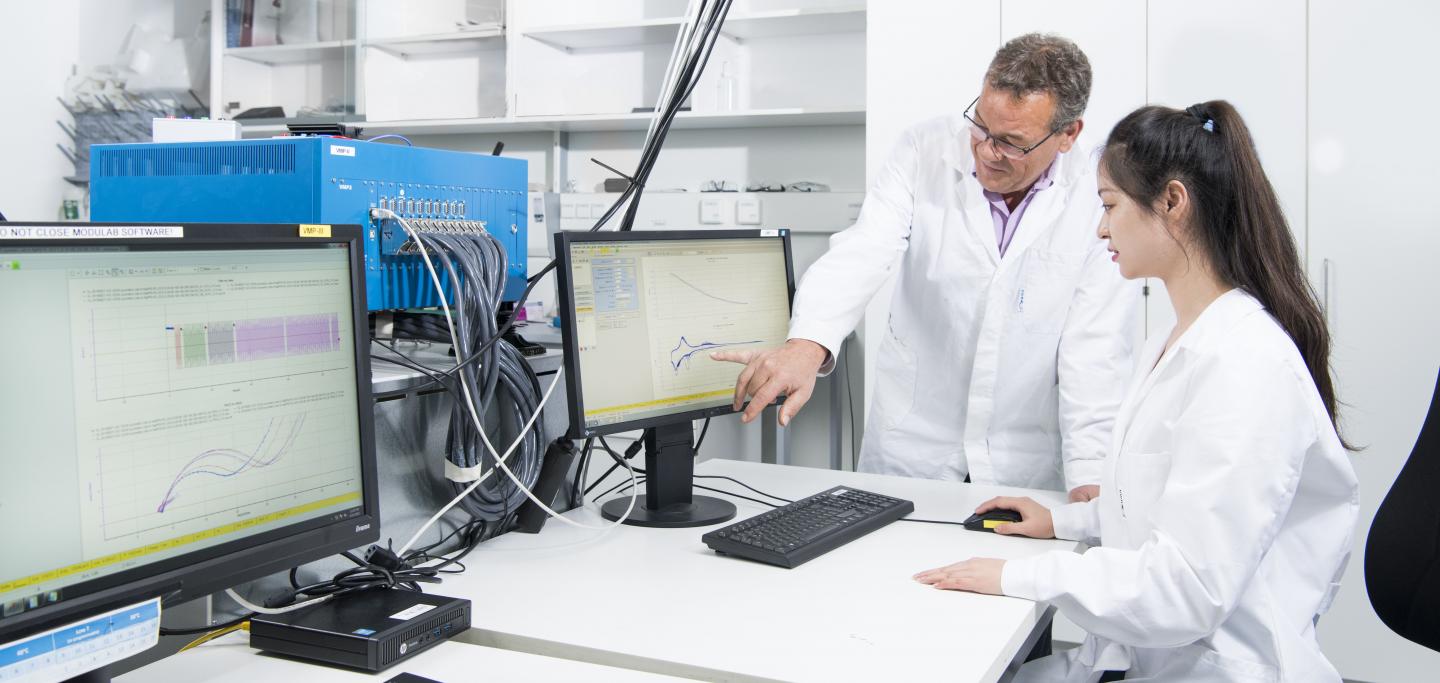Within the Si-DRIVE European Research Project, KIT, HIU, and partners will develop innovative solutions — their goal is to establish a European lithium-ion battery production

Credit: Photo: Amadeus Bramsiepe, KIT
Scientists of the Helmholtz Institute Ulm (HIU) founded by Karlsruhe Institute of Technology (KIT) and their European cooperation partners are developing a sustainable cell concept that is exclusively based on ecologically and economically uncritical materials. Within the Si-DRIVE project, the consortium analyzes the complete value-added chain of a battery and plans to establish European production by 2030. The project is funded by the European Union (EU) with EUR 8 million. The project duration is four years.
Presently, about 90 percent of the lithium-ion cells are produced in Asia. Various efforts are being undertaken to establish battery production in Europe. Si-DRIVE is aimed at developing a cell that consists of a nanostructured silicon anode, a novel solid electrolyte based on ionic liquids, and a completely cobalt-free, but lithium-rich cathode. A cell of this type and a comprehensive recycling program might enable sustainable battery production.
“Our program is special, as we cover all steps of the value-added chain of a battery, from materials development to prototype cell fabrication to recycling,” says Professor Stefano Passerini, Director of HIU. Within the project, his team will develop the novel, cobalt-free cathode material using uncritical elements, such as iron or aluminum. Cobalt is listed as a critical resource by the European Commission, as it is scarce and difficult to access geopolitically, which may cause supply shortages. Moreover, cobalt extraction in the Democratic Republic of the Congo – one of the main cobalt-exporting countries in the world – sometimes involves child labor and work under inhumane conditions. “In order to enhance energy density, we want to significantly increase the lithium content in the layered oxide cathode compared to conventional materials,” Passerini adds.
Five project partners will draft a circular economy concept to identify further applications. One of the scenarios is to combine aged batteries of electric cars and reuse them as stationary storage systems. Sustainability also plays an important role for the anode and electrolyte concept. Eventually, a recycling rate above fifty percent is to be achieved. The nanostructures of the anode are designed to ensure long cycle stability thanks to an ideal geometry with high mass loads. Modeling serves to optimize the anode structure. Volume expansion and mechanical deformation are to be buffered in the best possible way, while maximum energy density is to be maintained. The newly developed solid electrolyte is based on ionic liquids that increase stability at high voltages, enhance safety, and ensure low flammability.
The project funded under the Horizon 2020 European Framework Program for Research and Innovation pools activities of 17 scientific and industry partners from eight countries. With the groups of Professor Arnulf Latz from the German Aerospace Center (DLR) and of Dr. Margret Wohlfahrt-Mehrens from the Baden-Württemberg Center for Solar Energy and Hydrogen Research (ZSW), two other partners of HIU are involved.
###
About the Helmholtz Institute Ulm (HIU)
The HIU was established in January 2011 by Karlsruhe Institute of Technology (KIT), member of the Helmholtz Association, in cooperation with Ulm University. With the German Aerospace Center (DLR) and the Center for Solar Energy and Hydrogen Research Baden-Württemberg (ZSW), two other renowned institutions are involved in the HIU as associated partners. The international team of about 120 scientists at HIU works on the development of future energy storage systems for stationary and mobile use.
Find more on HIU at: http://www.
More about the KIT Energy Center: http://www.
Press contact:
Dr. Martin Heidelberger
Press Officer
Phone: +49 721 608-21169
Email: [email protected]
Being “The Research University in the Helmholtz Association”, KIT creates and imparts knowledge for the society and the environment. It is the objective to make significant contributions to the global challenges in the fields of energy, mobility and information. For this, about 9,300 employees cooperate in a broad range of disciplines in natural sciences, engineering sciences, economics, and the humanities and social sciences. KIT prepares its 25,100 students for responsible tasks in society, industry, and science by offering research-based study programs. Innovation efforts at KIT build a bridge between important scientific findings and their application for the benefit of society, economic prosperity, and the preservation of our natural basis of life.
This press release is available on the internet at http://www.
Media Contact
Monika Landgraf
[email protected]
Original Source
https:/



